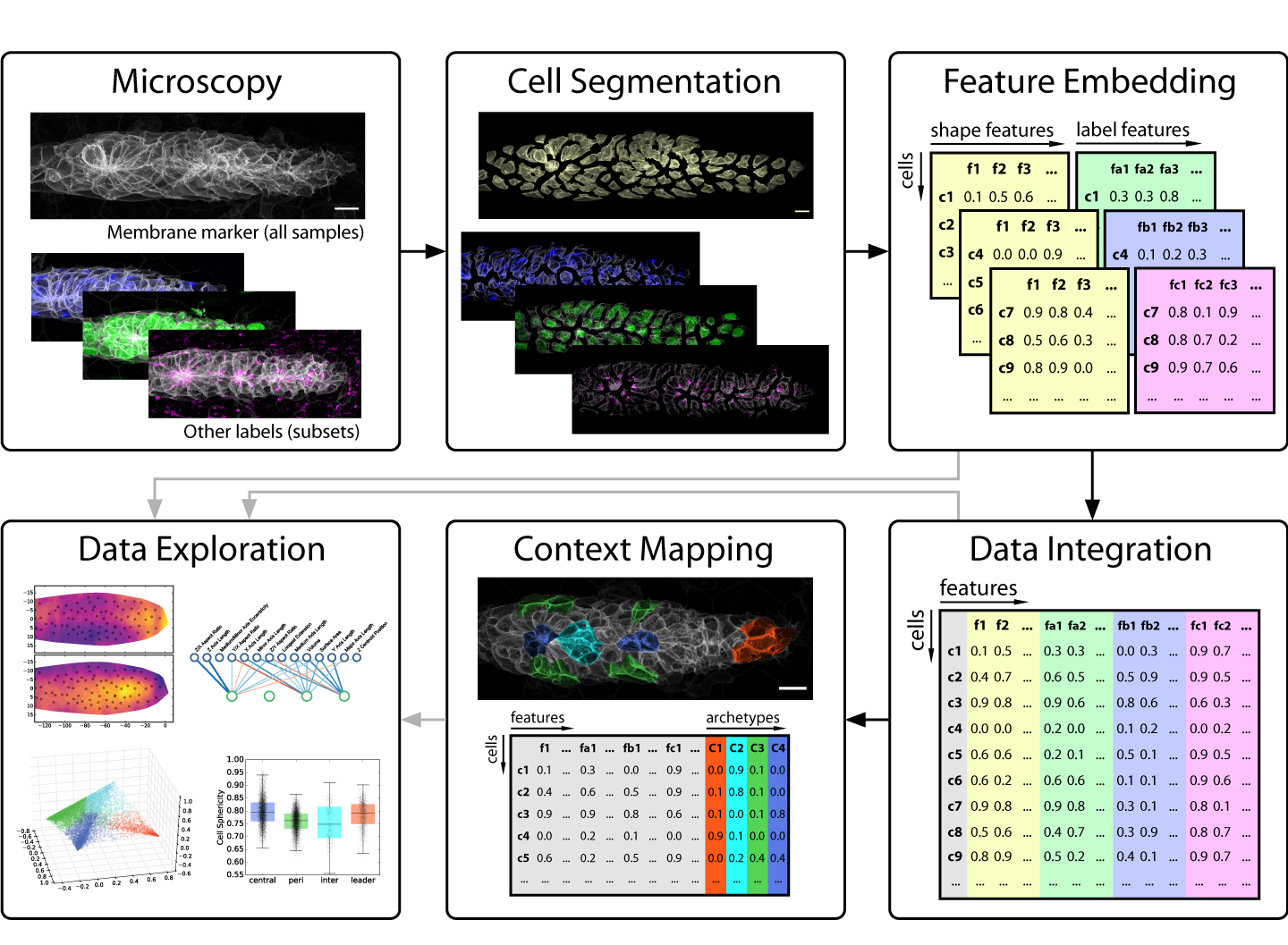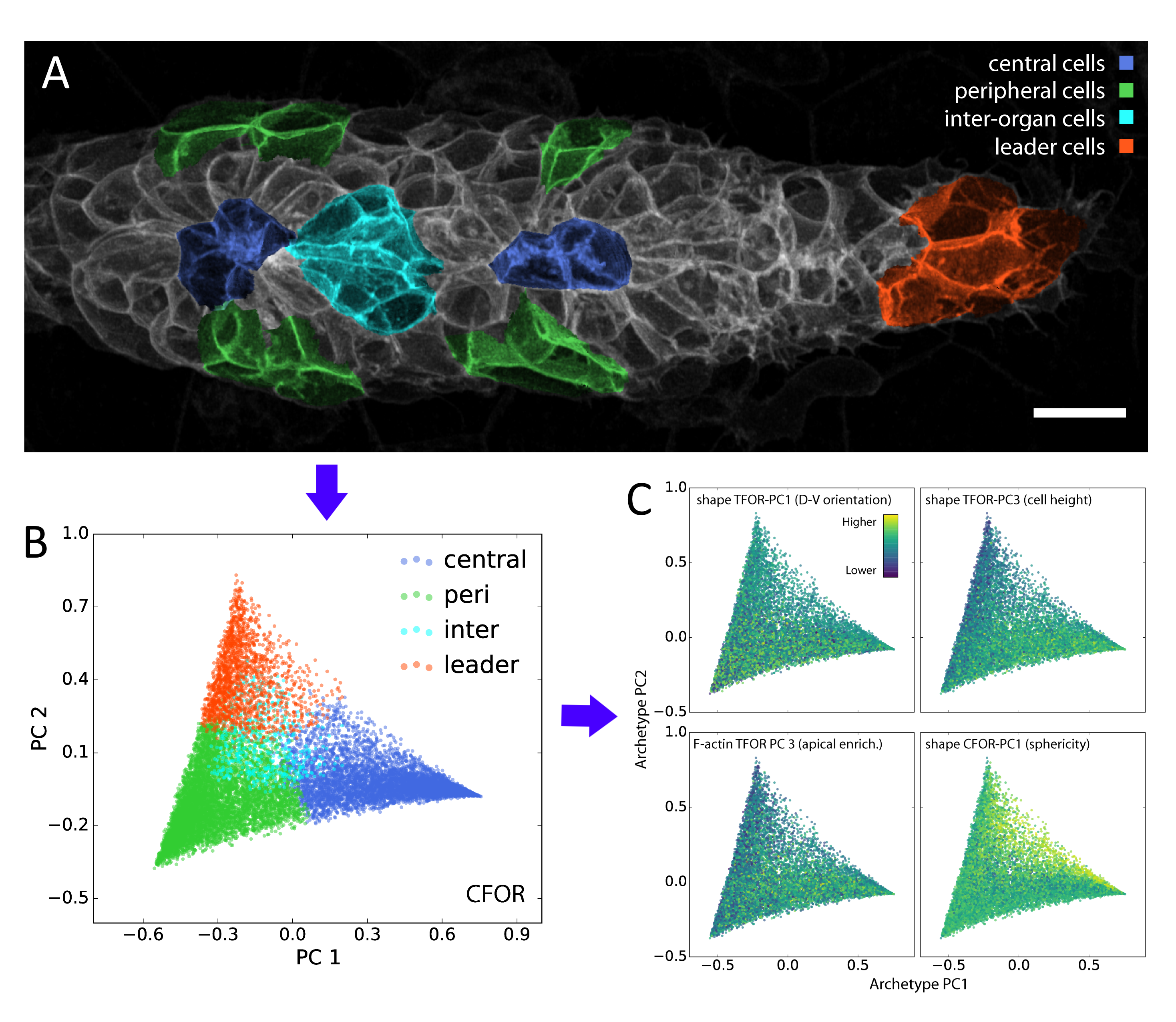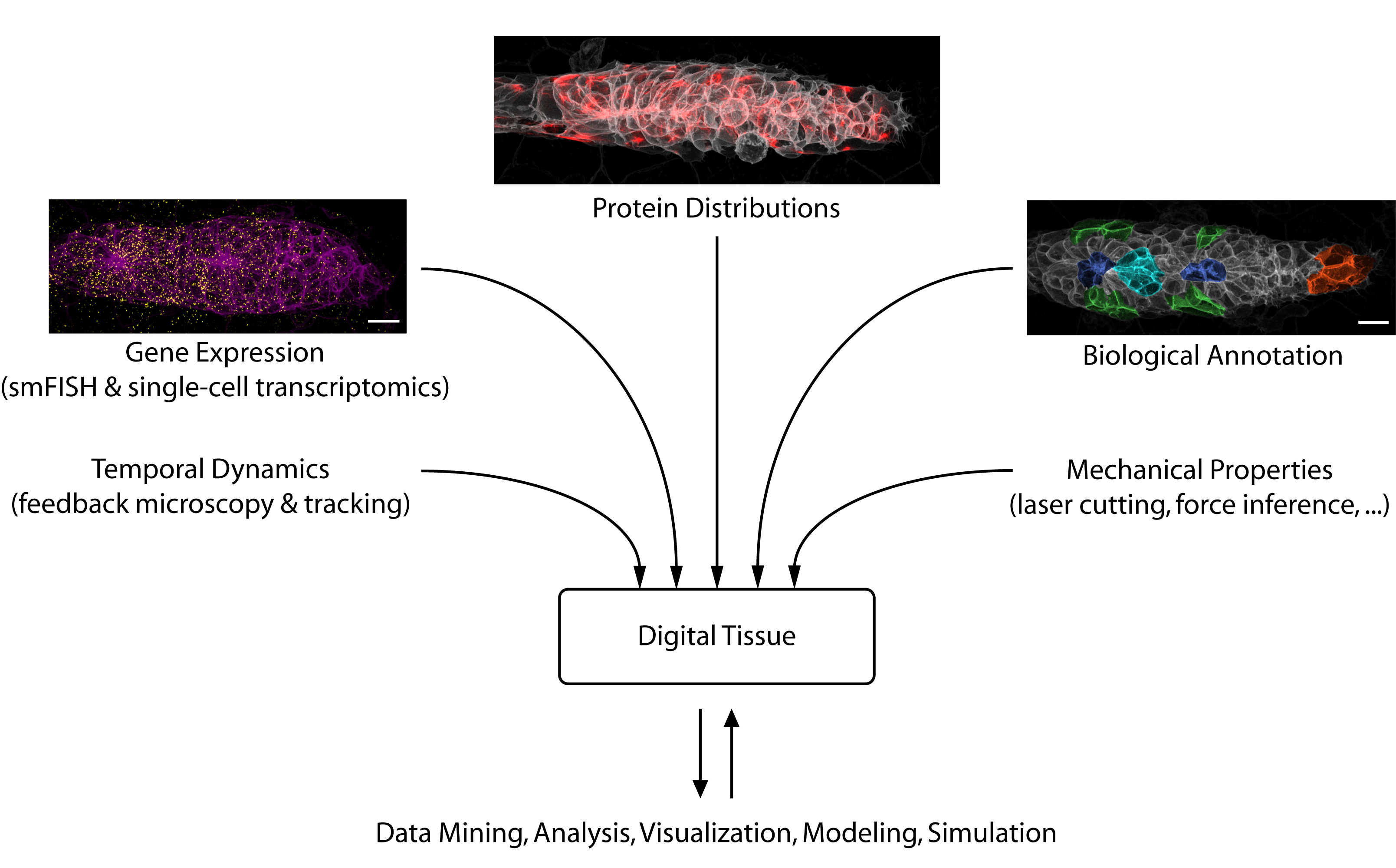September in preprints
Posted by the Node, on 1 October 2020
Welcome to our monthly trawl for developmental biology (and related) preprints.
The preprints this month are hosted on bioRxiv and arXiv – use these links to get to the section you want.
Developmental biology
| Stem cells, regeneration & disease modelling
Evo-devo & evo
Cell biology
Modelling
Tools & resources
Research practice & education
Developmental biology
| Patterning & signalling
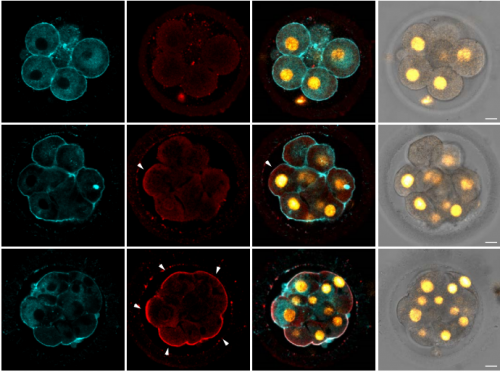
Mechanism of cell polarisation and first lineage segregation in the human embryo
Meng Zhu, Marta N. Shahbazi, Angel Martin, Chuanxin Zhang, Berna Sozen, Mate Borsos, Rachel S. Mandelbaum, Richard J. Paulson, Matteo A. Mole, Marga Esbert, Richard T. Scott, Alison Campbell, Simon Fishel, Viviana Gradinaru, Han Zhao, Keliang Wu, Zijiang Chen, Emre Seli, Maria J. de los Santos, Magdalena Zernicka-Goetz
Hedgehog signaling activates a heterochronic gene regulatory network to control differentiation timing across lineages
Megan Rowton, Carlos Perez-Cervantes, Ariel Rydeen, Suzy Hur, Jessica Jacobs-Li, Nikita Deng, Emery Lu, Alexander Guzzetta, Jeffrey D. Steimle, Andrew Hoffmann, Sonja Lazarevic, Xinan Holly Yang, Chul Kim, Shuhan Yu, Heather Eckart, Sabrina Iddir, Mervenaz Koska, Erika Hanson, Sunny Sun-Kin Chan, Daniel J. Garry, Michael Kyba, Anindita Basu, Kohta Ikegami, Sebastian Pott, Ivan P. Moskowitz
R-spondins are BMP receptor antagonists in early embryonic development
Hyeyoon Lee, Carina Seidl, Rui Sun, Andrei Glinka, Christof Niehrs
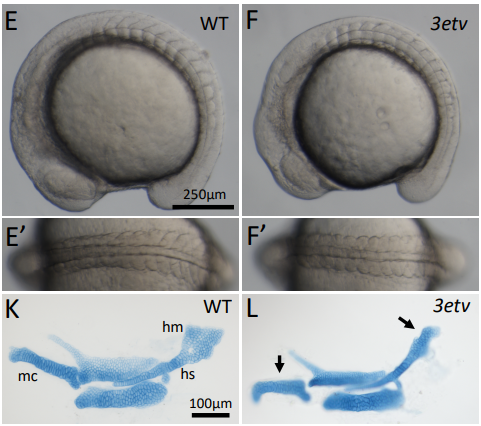
Loss of Fgf-responsive Pea3 transcription factors results in ciliopathy-associated phenotypes during early zebrafish development
Matt E. McFaul, Neta Hart, Bruce W. Draper
FGF8-mediated signaling regulates tooth growth rate and size during odontogenesis
Chensheng Lin, Ningsheng Ruan, Linjun Li, Yibin Chen, Xiaoxiao Hu, Xuefeng Hu, Yanding Zhang
Glypican4 mediates Wnt transport between germ layers via signaling filopodia
Bo Hu, Anurag Kakkerla Balaraju, Juan J Rodriguez, Yuanyuan Gao, Nhan T Nguyen, Heston Steen, Saeb Suhaib, Songhai Chen, Fang Lin
The Wnt effector TCF7l2 promotes oligodendroglial differentiation by repressing autocrine BMP4-mediated signaling
Sheng Zhang, Yan Wang, Xiaoqing Zhu, Lanying Song, Edric Ma, Jennifer McDonough, Hui Fu, Franca Cambi, Judith Grinspan, Fuzheng Guo
Thyroid hormone regulates proximodistal identity in the fin skeleton
Yinan Hu, Melody Harper, Benjamin Acosta, Joan Donahue, Hoa Bui, Hyungwoo Lee, Stacy Nguyen, Sarah McMenamin
NANOS2 suppresses the cell cycle by repressing mTORC1 activators in embryonic male germ cells
Ryuki Shimada, Hiroko Koike, Takamasa Hirano, Yumiko Saga
Endothelial-to-hematopoietic transition is induced by Notch glycosylation and upregulation of Mycn
Briane Laruy, Irene Garcia-Gonzalez, Veronica Casquero-Garcia, Rui Benedito
Association of Sonic Hedgehog with the extracellular matrix requires its zinc-coordination fold
Carina Jägers, Henk Roelink
Regulation of retinal neurogenesis by somatostatin signaling
Kurt Weir, Dong Won Kim, Seth Blackshaw
Midkine in chick and mouse retinas: neuroprotection, glial reactivity and the formation of Müller glia-derived progenitor cells
Warren A. Campbell, Amanda Fritsch-Kelleher, Isabella Palazzo, Thanh Hoang, Seth Blackshaw, Andy J. Fischer
Granulosa cell genes that regulate ovarian follicle development beyond the antral stage: the role of estrogen receptor β
V. Praveen Chakravarthi, Shaon Borosha, Subhra Ghosh, Katherine F. Roby, Michael W. Wolfe, Lane K. Christenson, M. A. Karim Rumi
Two voltage-dependent currents can explain the functional diversity of embryonic Renshaw cells
Juliette Boeri, Claude Meunier, Hervé Le Corronc, Pascal Branchereau, Yulia Timofeeva, François Xavier Lejeune, Christine Mouffle, Hervé Arulkandarajah, Jean Marie Mangin, Pascal Legendre, Antonny Czarnecki
Enhanced ongoing endogenous activity predicts elimination of adult-born neurons in the mouse olfactory bulb
Xin Su, Yury Kovalchuk, Nima Mojtahedi, Olga Garaschuk
The organization and developmental establishment of cortical interneuron presynaptic circuits
Gabrielle Pouchelon, Yannick Bollmann, Elaine Fisher, Chimuanya K Agba, Qing Xu, Kimberly D Ritola, Andrea MC Mirow, Sehyun Kim, Rosa Cossart, Gord Fishell
Identifying Isl1 genetic lineage in the developing olfactory system and in GnRH-1 neurons
Ed Zandro M. Taroc, Raghu Ram Katreddi, Paolo E. Forni
Nkx2-5 defines distinct scaffold and recruitment phases during formation of the cardiac Purkinje fiber network
Caroline Choquet, Robert G. Kelly, Lucile Miquerol
Identification of Biomarkers Controlling Cell Fate In Blood Cell Development
Maryam Nazarieh, Volkhard Helms, Marc P. Hoeppner, Andre Franke
Proneural genes define ground state rules to regulate neurogenic patterning and cortical folding
Sisu Han, Grey A Wilkinson, Satoshi Okawa, Lata Adnani, Rajiv Dixit, Imrul Faisal, Matthew Brooks, Veronique Cortay, Vorapin Chinchalongporn, Dawn Zinyk, Saiqun Li, Jinghua Gao, Faizan Malik, Yacine Touahri, Vladimir Espinosa Angarica, Ana-Maria Oproescu, Eko Raharjo, Yaroslav Ilnytskyy, Jung-Woong Kim, Wei Wu, Waleed Rahmani, Igor Kovalchuk, Jennifer Ai-wen Chan, Deborah Kurrasch, Diogo S. Castro, Colette Dehay, Anand Swaroop, Jeff Biernaskie, Antonio del Sol, Carol Schuurmans
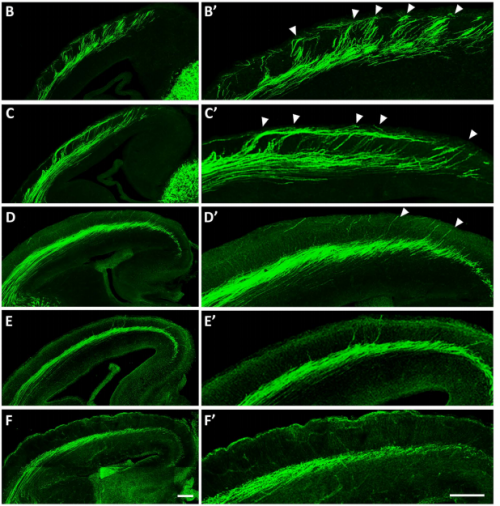
An early cortical progenitor-specific mechanism regulates thalamocortical innervation
Suranjana Pal, Deepanjali Dwivedi, Tuli Pramanik, Geeta Godbole, Takuji Iwasato, Denis Jabaudon, Upinder S. Bhalla, Shubha Tole
Fine-tuning of Epithelial EGFR signals Supports Coordinated Mammary Gland Development
Alexandr Samocha, Hanna M. Doh, Vaishnavi Sitarama, Quy H. Nguyen, Oghenekevwe Gbenedio, Joshua D. Rudolf, Walter L. Eckalbar, Andrea J. Barczak, Yi Miao, K. Christopher Garcia, Devon Lawson, Zena Werb, Kai Kessenbrock, Philippe Depeille, Jeroen P. Roose
Atypical TGF-β Signaling Controls Neuronal Guidance in Caenorhabditis elegans
Oguzhan Baltaci, Mikael Egebjerg Pedersen, Tessa Sherry, Ava Handley, Goda Snieckute, Matilda Haas, Stuart Archer, Roger Pocock
Temporal scaling in C. elegans larval development
Olga Filina, Rik Haagmans, Jeroen S. van Zon
Syd/JIP3 Controls Tissue Size by Regulating Diap1 Protein Turnover Downstream of Yorkie/YAP
Vakil Ahmad, Gangadhar P. Vadla, Chiswili Y. Chabu
Maintaining robust size across environmental conditions is achieved through plastic growth dynamics in the central nervous system of Drosophila melanogaster
Ansa E. Cobham, Brent Neumann, Christen K. Mirth
Coordination Among Multiple Receptor Tyrosine Kinase Signals Controls Drosophila Developmental Timing and Body Size
Xueyang Pan, Michael B. O’Connor
Glial Hedgehog and lipid metabolism regulate neural stem cell proliferation in Drosophila
Qian Dong, Michael Zavortink, Francesca Froldi, Sofya Golenkina, Tammy Lam, Louise Y. Cheng
| Morphogenesis & mechanics
Cellular mechanisms of chick limb bud morphogenesis
Gaja Lesnicar-Pucko, Julio M Belmonte, Marco Musy, James A. Glazier, James Sharpe
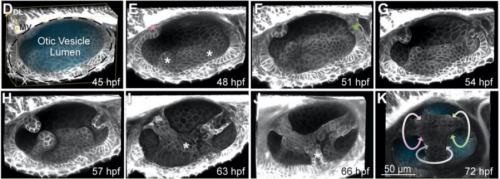
Extracellular hyaluronate pressure shaped by cellular tethers drives tissue morphogenesis
Akankshi Munjal, Edouard Hannezo, Timothy Mitchison, Sean Megason
Stretching of the retinal pigment epithelium contributes to zebrafish optic cup morphogenesis
Tania Moreno-Mármol, Mario Ledesma-Terrón, Noemí Tabanera, María Jesús Martin-Bermejo, Marcos J Cardozo, Florencia Cavodeassi, Paola Bovolenta

Multiscale analysis of single and double maternal-zygotic Myh9 and Myh10 mutants during mouse preimplantation development
Markus Frederik Schliffka, Anna-Francesca Tortorelli, Özge Özgüç, Ludmilla de Plater, Oliver Polzer, Diane Pelzer, Jean-Léon Maître
Basal epidermis collective migration and local Sonic hedgehog signaling promote skeletal branching morphogenesis in zebrafish fins
Joshua A. Braunstein, Amy E. Robbins, Scott Stewart, Kryn Stankunas
Twinfilin1 controls lamellipodial protrusive activity and actin turnover during vertebrate gastrulation
Caitlin C. Devitt, Chanjae Lee, Rachael M. Cox, Ophelia Papoulas, José Alvarado, Edward M. Marcotte, John B. Wallingford
Scribble mutation disrupts convergent extension and apical constriction during mammalian neural tube closure
Alyssa C. Lesko, Raymond Keller, Ping Chen, Ann Sutherland
Cell – ECM interactions play distinct and essential roles at multiple stages during the development of the aortic arch arteries
Michael Warkala, Dongying Chen, Ali Jubran, AnnJosette Ramirez, Michael Schonning, Xia Wang, Huaning Zhao, Sophie Astrof
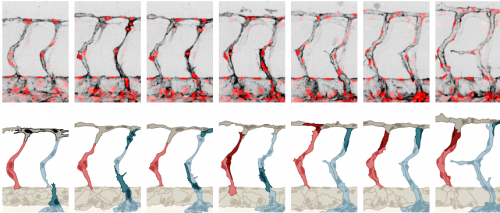
Wasp controls oriented migration of endothelial cells to achieve functional vascular patterning
André Rosa, Wolfgang Giese, Katja Meier, Silvanus Alt, Alexandra Klaus-Bergmann, Lowell Edgar, Eireen Bartels, Russell Collins, Anna Szymborska-Mell, Baptiste Coxam, Miguel O. Bernabeu, Holger Gerhardt
Rcn3 is Involved in Postnatal Tendon Development by Regulating Collagen Modification and Fibrillogenesis
Na Rae Park, Snehal Shetye, Douglas R. Keene, Sara Tufa, David M. Hudson, Marilyn Archer, Louis J Soslowsky, Nathaniel A. Dyment, Kyu Sang Joeng
Control of dynamic cell behaviors during angiogenesis and anastomosis by Rasip 1
Minkyoung Lee, Charles Betz, Ilkka Paatero, Niels Schellinx, Jianmin Yin, Christopher William Wilson, Weilan Ye, Markus Affolter, Heinz-Georg Belting
The extracellular matrix protein agrin is essential for epicardial epithelial-to-mesenchymal transition during heart development
Xin Sun, Sophia Malandraki-Miller, Tahnee Kennedy, Elad Bassat, Konstantinos Klaourakis, Jia Zhao, Elisabetta Gamen, Joaquim Miguel Vieira, Eldad Tzahor, Paul R. Riley
Mechano-chemical feedback leads to cell competition for cell fate specification
J. Toddie-Moore Daniel, P. Montanari Martin, Isaac Salazar-Ciudad, Osamu Shimmi
Degenerating Drosophila Larval Epidermal Cells Drive Thorax Closure
Thamarailingam Athilingam, Saurabh Singh Parihar, Rachita Bhattacharya, Mohd. Suhail Rizvi, Amit Kumar, Pradip Sinha
Tissue topography steers migrating Drosophila border cells
Wei Dai, Xiaoran Guo, Yuansheng Cao, James A. Mondo, Joseph P. Campanale, Brandon J. Montell, Haley Burrous, Sebastian Streichan, Nir Gov, Wouter Jan Rappel, Denise J. Montell
Coordinated assembly and release of adhesions builds apical junctional belts during de novo polarisation of an epithelial tube
Andrew C Symonds, Clare E Buckley, Charlotte A Williams, Jonathan DW Clarke
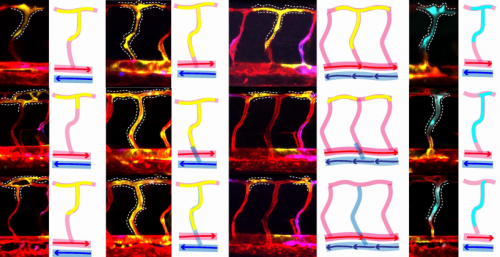
Heterogeneity in collective endothelial cell behavior is a driver of arterio-venous remodeling
Keyi Jiang, Cathy Pichol-Thievend, Zoltan Neufeld, Mathias Francois
Topological defects in the nematic order of actin fibers as organization centers of Hydra morphogenesis
Yonit Maroudas-Sacks, Liora Garion, Lital Shani-Zerbib, Anton Livshits, Erez Braun, Kinneret Keren
CARMIL3 is important for cell migration and morphogenesis during early development in zebrafish
Benjamin C. Stark, Yuanyuan Gao, Lakyn Belk, Matthew A. Culver, Bo Hu, Diane S. Sepich, Marlene Mekel, Lilianna Solnica-Krezel, Fang Lin, John A. Cooper
Nf2 fine-tunes proliferation and tissue alignment during closure of the optic fissure in the embryonic mouse eye
Wesley R Sun, Sara Ramirez, Kelly E Spiller, Yan Zhao, Sabine Fuhrmann
The microtubule organization in the zebrafish yolk adapts to transgene-mediated phenotypic variations
Maria Marsal, Matteo Bernardello, Emilio J. Gualda, Pablo Loza-Alvarez
The Arf-GEF Steppke promotes F-actin accumulation, cell protrusions and tissue sealing during Drosophila dorsal closure
Junior J. West, Tony J. C. Harris
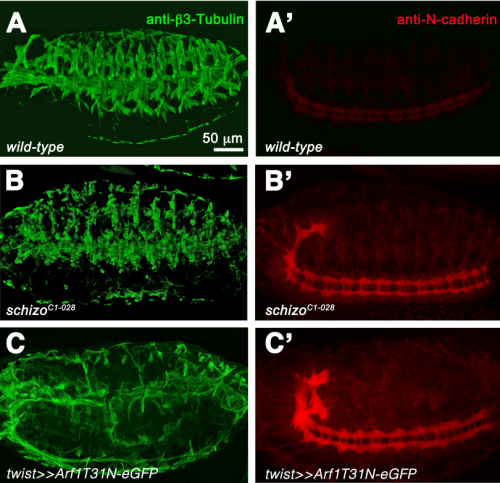
The Abl-interactor Abi suppresses the function of the BRAG2 GEF family member Schizo
Susanne Filiz Önel, Stefanie Lübke, Carina Braukmann, Karl-Heinz Rexer, Lubjinka Cigoja
Dscam1 promotes blood cell survival in Drosophila melanogaster through a dual role in blood cells and neurons
Debra Ouyang, Xiaoyi Xiao, Anjeli Mase, Glenda Li, Sean Corcoran, Fei Wang, Katja Brückner
Planar cell polarity in the larval epidermis of Drosophila and the role of microtubules
Stefano Pietra, KangBo Ng, Peter A. Lawrence, José Casal
Dynamics of hydraulic and contractile wave-mediated fluid transport during Drosophila oogenesis
Jasmin Imran Alsous, Nicolas Romeo, Jonathan A. Jackson, Frank Mason, Jörn Dunkel, Adam C. Martin
Formation of polarized contractile interfaces by self-organized Toll-8/Cirl GPCR asymmetry
Jules Lavalou, Qiyan Mao, Stefan Harmansa, Stephen Kerridge, Annemarie C. Lellouch, Jean-Marc Philippe, Stephane Audebert, Luc Camoin, Thomas Lecuit
RhoGAP19D inhibits Cdc42 laterally to control epithelial cell shape and prevent invasion
Weronika Fic, Rebecca Bastock, Francesco Raimondi, Erinn Los, Yoshiko Inoue, Jennifer Gallop, Robert B. Russell, Daniel St Johnston
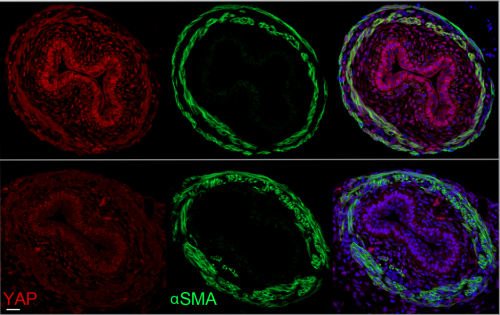
Ciliary signaling-patterned smooth muscle drives tubular elongation
Ying Yang, Pekka Paivinen, Chang Xie, Alexis Leigh Krup, Tomi P. Makela, Keith E. Mostov, Jeremy F. Reiter
The atypical Rho GTPase Rnd2 is critical for dentate granule neuron development and anxiety-like behavior during adult but not neonatal neurogenesis
Thomas Kerloch, Fanny Farrugia, Marlène Maître, Geoffrey Terral, Muriel Koehl, Julian Ik-Tsen Heng, Mylène Blanchard, Hélène Doat, Thierry Leste-Lasserre, Adeline Goron, Delphine Gonzales, François Guillemot, Djoher Nora Abrous, Emilie Pacary
Type II collagen-positive progenitors are major stem cells to control skeleton development and vascular formation
Xinhua Li, Shuting Yang, Dian Jing, Lin Qin, Hu Zhao, Shuying Yang
Mechanical compartmentalization of the intestinal organoid enables crypt folding and collective cell migration
Carlos Pérez-González, Gerardo Ceada, Francesco Greco, Marija Matejcic, Manuel Gómez-González, Natalia Castro, Sohan Kale, Adrián Álvarez-Varela, Pere Roca-Cusachs, Eduard Batlle, Danijela Matic Vignjevic, Marino Arroyo, Xavier Trepat

Slit2 is essential for correct retinal ganglion cell axon fasciculation and midline crossing in the zebrafish
Camila Davison, Flavio R. Zolessi
| Genes & genomes
Topology-driven protein-protein interaction network analysis detects genetic sub-networks regulating reproductive capacity
Tarun Kumar, Leo Blondel, Cassandra G. Extavour
Trajectory Mapping of the Early Drosophila Germline Reveals Controls of Zygotic Activation and Sex Differentiation
Hsing-Chun Chen, Yi-Ru Li, Hsiao Wen Lai, Hsiao Han Huang, Sebastian D. Fugmann, Shu Yuan Yang
The haplolethality paradox of the wupA gene in Drosophila
Sergio Casas-Tintó, Alberto Ferrús
Live imaging and biophysical modeling support a button-based mechanism of somatic homolog pairing in Drosophila
Myron Child VI, Jack R. Bateman, Amir Jahangiri, Armando Reimer, Nicholas C. Lammers, Nica Sabouni, Diego Villamarin, Grace C. McKenzie-Smith, Justine E. Johnson, Daniel Jost, Hernan G. Garcia
Temporal evolution of single-cell transcriptomes of Drosophila olfactory projection neurons
Qijing Xie, Maria Brbic, Felix Horns, Sai Saroja Kolluru, Bob Jones, Jiefu Li, Anay Reddy, Anthony Xie, Sayeh Kohani, Zhuoran Li, Colleen McLaughlin, Tongchao Li, Chuanyun Xu, David Vacek, David J. Luginbuhl, Jure Leskovec, Stephen R. Quake, Liqun Luo, Hongjie Li
Neuronal perception of the social environment intergenerationally controls germline development and generation time in C. elegans
Marcos Francisco Perez, Mehrnaz Shamalnasab, Alejandro Mata-Cabana, Simona Della Valle, María Olmedo, Mirko Francesconi, Ben Lehner
Chromatin-associated effectors of energy-sensing pathways mediate intergenerational effects
Pedro Robles, Anisa Turner, Giusy Zuco, Panagiota Paganopolou, Beth Hill, Vikas Kache, Christine Bateson, Andre Pires-daSilva
FHOD formin and SRF promote striated muscle development through separate pathways in C. elegans
Curtis V. Yingling, David Pruyne
A temporally resolved transcriptome for developing “Keller” explants of the Xenopus laevis dorsal marginal zone
Anneke D. Kakebeen, Robert Huebner, Asako Shindo, Kujin Kwon, Taejoon Kwon, Andrea E. Wills, John B. Wallingford
De novo DNA methylation controls neuronal maturation during adult hippocampal neurogenesis
Sara Zocher, Rupert W Overall, Gabriel Berdugo-Vega, Nicole Rund, Anne Karasinsky, Vijay S Adusumilli, Christina Steinhauer, Sina Scheibenstock, Kristian Händler, Joachim L Schultze, Federico Calegari, Gerd Kempermann

Rad21l1 cohesin subunit is dispensable for spermatogenesis but not oogenesis in zebrafish
Yana P. Blokhina, Michelle Frees, An Nguyen, Masuda Sharifi, Daniel B. Chu, Bruce W. Draper, Sean M. Burgess
Early-life environment programs reproductive strategies through epigenetic regulation of SRD5A1
Ben Bar-Sadeh, Or Eden, Lilach Pnueli, Kurshida Begum, Gregory Leeman, Richard D. Emes, Reinhard Stöger, Gillian R. Bentley, Philippa Melamed
DNA Methylation Reprogramming during Sex Determination and Transition in Zebrafish
Xinxin Wang, Xin Ma, Gaobo Wei, Weirui Ma, Zhen Zhang, Xuepeng Chen, Lei Gao, Zhenbo Liu, Yue Yuan, Lizhi Yi, Jun Wang, Toshinobu Tokumoto, Junjiu Huang, Dahua Chen, Jian Zhang, Jiang Liu
Transcriptional bursting shape autosomal dynamic random monoallelic expression in pre-gastrulation embryos
C H Naik, D Chandel, S Mandal, S Gayen
TWIST1 and chromatin regulatory proteins interact to guide neural crest cell differentiation
Xiaochen Fan, V. Pragathi Masamsetti, Jane Q. J. Sun, Kasper Engholm-Keller, Pierre Osteil, Joshua Studdert, Mark E. Graham, Nicolas Fossat, Patrick P.L. Tam
Etv5 is not required for Schwann cell development but is required to regulate the Schwann cell response to peripheral nerve injury
Anjali Balakrishnan, Lauren Belfiore, Lakshmy Vasan, Yacine Touahri, Morgan Stykel, Taylor Fleming, Rajiv Midha, Jeff Biernaskie, Carol Schuurmans
DAF-18/PTEN inhibits germline zygotic gene activation during primordial germ cell quiescence
Amanda L. Fry, Amy Webster, Rojin Chitrakar, L. Ryan Baugh, E. Jane Albert Hubbard
RUNX1 marks a luminal castration resistant lineage established at the onset of prostate development
Renaud Mevel, Ivana Steiner, Susan Mason, Laura C.A. Galbraith, Rahima Patel, Muhammad ZH Fadlullah, Imran Ahmad, Hing Y. Leung, Pedro Oliveira, Karen Blyth, Esther Baena, Georges Lacaud
Ets2 frame-shift mutant models express in-frame mRNA by exon skipping that complements Ets2 function in the skin
Yuki Kishimoto, Iori Nishiura, Shunsuke Yuri, Nami Yamamoto, Masahito Ikawa, Ayako Isotani
Lyl-1 marks and regulates primitive macrophages and microglia development
Shoutang Wang, Deshan Ren, Anna-Lila Kaushik, Gabriel Matherat, Yann Lécluse, Dominik Filipp, William Vainchenker, Hana Raslova, Isabelle Plo, Isabelle Godin

Homeotic Regulation of Olfactory Receptor Choice via NFI-dependent Heterochromatic Silencing and Genomic Compartmentalization
Elizaveta Bashkirova, Kevin Monahan, Christine E. Campbell, Jason M. Osinski, Longzhi Tan, Ira Schieren, Gilad Barnea, X. Sunnie Xie, Richard M. Gronostajski, Stavros Lomvardas
Primary sex determination in chickens depends on DMRT1 dosage, but gonadal sex does not determine secondary sexual characteristics in adult birds
Jason Ioannidis, Gunes Taylor, Debiao Zhao, Long Liu, Alewo Idoko-Akoh, Daoqing Gong, Robin Lovell-Badge, Silvana Guioli, Mike McGrew, Michael Clinton
Lung lineage transcription factor NKX2-1 epigenetically resolves opposing cell fates in vivo
Danielle R. Little, Anne M. Lynch, Yun Yan, Haruhiko Akiyama, Shioko Kimura, Jichao Chen
Transcription factors from multiple families ensure enhancer selectivity and robust neuron terminal differentiation
Angela Jimeno-Martín, Erick Sousa, Noemi Daroqui, Rebeca Brocal-Ruiz, Miren Maicas, Nuria Flames
SATB homeobox 1 regulated genes in the mouse ectoplacental cone are important for placental development
V. Praveen Chakravarthi, Shaon Borosha, Anamika Ratri, Subhra Ghosh, Michael W. Wolfe, M. A. Karim Rumi
Synergistic activity of Nanog, Pou5f3, and Sox19b establishes chromatin accessibility and developmental competence in a context-dependent manner
Liyun Miao, Yin Tang, Ashley R. Bonneau, Shun Hang Chan, Mina L. Kojima, Mark E. Pownall, Charles E. Vejnar, Antonio J. Giraldez

The piRNA pathway sustains adult neurogenesis by repressing protein synthesis
C. Gasperini, R. Pelizzoli, A. Lo Van, D. Mangoni, R.M. Cossu, G. Pascarella, P. Bianchini, P. Bielefeld, M. Scarpato, M. Pons-Espinal, R. Sanges, A. Diaspro, C.P. Fitzsimons, P. Carninci, S. Gustincich, D De Pietri Tonelli
CTCF knockout in zebrafish induces alterations in regulatory landscapes and developmental gene expression
Martin Franke, Elisa De la Calle-Mustienes, Ana Neto, Rafael D. Acemel, Juan J. Tena, José M. Santos-Pereira, José L. Gómez-Skarmeta
Mouse fertilization triggers a conserved transcription program in one-cell embryos
Maki Asami, Brian Y. H. Lam, Martin Hoffmann, Toru Suzuki, Xin Lu, Matthew D. VerMilyea, Naoko Yoshida, Marcella K. Ma, Kara Rainbow, Stefanie Braun, Nina Patwary, Giles S. H. Yeo, Christoph A. Klein, Anthony C. F. Perry
Divergent DNA methylation signatures of X chromosome regulation in marsupials and eutherians
Devika Singh, Dan Sun, Andrew G. King, David E. Alquezar-Planas, Rebecca N. Johnson, David Alvarez-Ponce, Soojin V. Yi
Translatomic database of cortical astroglia across male and female mouse development reveals two distinct developmental phenotypes
Gareth M. Rurak, Stephanie Simard, François Charih, Amanda Van Geel, John Stead, Barbara Woodside, James R. Green, Gianfilippo Coppola, Natalina Salmaso
Single cell analysis reveals the impact of age and maturation stage on the human oocyte transcriptome
Silvia Llonch, Montserrat Barragán, Paula Nieto, Anna Mallol, Marc Elosua-Bayes, Patricia Lorden, Sara Ruiz, Filippo Zambelli, Holger Heyn, Rita Vassena, Bernhard Payer
| Stem cells, regeneration & disease modelling

Capture of mouse and human stem cells with features of formative pluripotency
Masaki Kinoshita, Michael Barber, William Mansfield, Yingzhi Cui, Daniel Spindlow, Giuliano Giuseppe Stirparo, Sabine Dietmann, Jennifer Nichols, Austin Smith
Auxin-degron system identifies immediate mechanisms of Oct4
Lawrence E Bates, Mariana R P Alves, José C R Silva
Generation of human induced trophoblast stem cells
Gaël Castel, Dimitri Meistermann, Betty Bretin, Julie Firmin, Justine Blin, Sophie Loubersac, Alexandre Bruneau, Simon Chevolleau, Stephanie Kilens, Caroline Chariau, Anne Gaignerie, Quentin Francheteau, Harunobu Kagawa, Eric Charpentier, Léa Flippe, Valentin Francois – – Campion, Sandra Haider, Bianca Dietrich, Martin Knöfler, Takahiro Arima, Jérémie Bourdon, Nicolas Rivron, Damien Masson, Thierry Fournier, Hiroaki Okae, Thomas Freour, Laurent David
A long-range chromatin interaction regulates SATB homeobox 1 gene expression in trophoblast stem cells
Wei Yu, V. Praveen Chakravarthi, Shaon Borosha, Anamika Ratri, Khyati Dalal, Michael W. Wolfe, Rebekah R. Starks, Geetu Tuteja, M.A. Karim Rumi
Differential expression of transposable elements in stem cell lineages of the preimplantation embryo
Eddie Dai, Nehemiah S. Alvarez, M. A. Karim Rumi
Comparative Parallel Multi-Omics Analysis During the Induction of Pluripotent and Trophectoderm States
Mohammad Jaber, Ahmed Radwan, Netanel Loyfer, Mufeed Abdeen, Shulamit Sebban, Thorsten Kolb, Marc Zapatka, Kirill Makedonski, Aurelie Ernst, Tommy Kaplan, Yosef Buganim
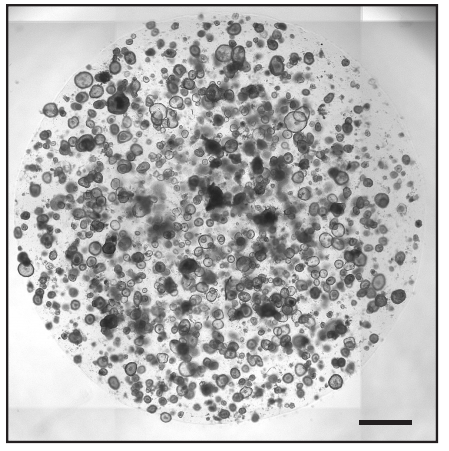
Robust differentiation of human enteroendocrine cells from intestinal stem cells
Daniel Zeve, Eric Stas, Xiaolei Yin, Sarah Dubois, Manasvi S. Shah, Erin P. Syverson, Sophie Hafner, Jeffrey M. Karp, Diana L. Carlone, David T. Breault
Interspecies Chimeric Conditions Affect the Developmental Rate of Human Pluripotent Stem Cells
Jared Brown, Christopher Barry, Matthew T. Schmitz, Cara Argus, Jennifer M. Bolin, Michael P. Schwartz, Amy Van Aartsen, John Steill, Scott Swanson, Ron Stewart, James A. Thomson, Christina Kendziorski

Peripheral microtubules ensure asymmetric furrow positioning in neural stem cells
Alexandre Thomas, Emmanuel Gallaud, Aude Pascal, Laurence Serre, Isabelle Arnal, Laurent Richard-Parpaillon, Matthew Scott Savoian, Régis Giet
The transcription factor ZEB1 regulates stem cell self-renewal and astroglial fate in the adult hippocampus
B Gupta, AC Errington, S Brabletz, MP Stemmler, T Brabletz, FA Siebzehnrubl
Role of hemocytes in the regeneration of germline stem cells in Drosophila
Virginia Beatrix Varga, Fanni Szikszai, Janka Szinyákovics, Anna Manzéger, Gina Puska, Tibor Kovács, Tibor Vellai
Repression by hdac3 and dax1 mediates lineage restriction of embryonic stem cells
Daniel Olivieri, Panagiotis Papasaikas, Ilya Lukonin, Melanie Rittirsch, Daniel Hess, Sébastien A. Smallwood, Michael B. Stadler, Joerg Betschinger
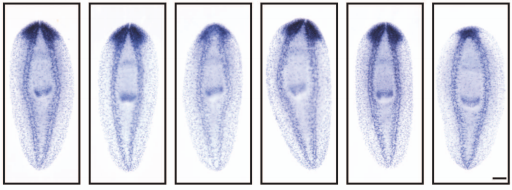
CBP/p300 orthologs CBP2 and CBP3 play distinct roles in planarian stem cell function
Clara R. Stelman, Britessia M. Smith, Bidushi Chandra, Rachel H. Roberts-Galbraith
Planarian CREB-binding protein (CBP) gene family regulates stem cell maintenance and differentiation
Susanna Fraguas, Sheila Cárcel, Coral Vivancos, Ma Dolores Molina, Jordi Ginés, Judith Mazariegos, Thileepan Sekaran, Kerstin Bartscherer, Rafael Romero, Francesc Cebrià
Selective silencing rather than targeted activation of gene expression underlies fate choice in human hematopoietic stem cells
R Parmentier, A Moussy, S Chantalat, L Racine, R Sudharshan, N Papili Gao, D Stockholm, G Corre, JF Deleuze, R Gunawan, A Paldi
Unexpected redundancy of Gpr56 and Gpr97 during hematopoietic cell development and differentiation
A. Maglitto, S.A. Mariani, E. de Pater, C. Rodriguez-Seoane, C.S. Vink, X. Piao, M.-L. Lukke, E. Dzierzak
Loss of Nupr1 promotes engraftment by tuning the quiescence threshold of hematopoietic stem cell repository via regulating p53-checkpoint pathway
Tongjie Wang, Chengxiang Xia, Qitong Weng, Kaitao Wang, Yong Dong, Sha Hao, Fang Dong, Xiaofei Liu, Lijuan Liu, Yang Geng, Yuxian Guan, Juan Du, Tao Cheng, Hui Cheng, Jinyong Wang
Leveraging complex interactions between signaling pathways involved in liver development to robustly improve the maturity and yield of pluripotent stem cell-derived hepatocytes
Claudia Raggi, Marie-Agnès M’Callum, Quang Toan Pham, Perrine Gaub, Silvia Selleri, Nissan Baratang, Chenicka Lyn Mangahas, Gaël Cagnone, Bruno Reversade, Jean-Sébastien Joyal, Massimiliano Paganelli
Reconstitution of prospermatogonial specification in vitro from human induced pluripotent stem cells
Young Sun Hwang, Shinnosuke Suzuki, Yasunari Seita, Jumpei Ito, Yuka Sakata, Hirofumi Aso, Kei Sato, Brian P. Hermann, Kotaro Sasaki
Self-assembly of progenitor cells under the aegis of platelet factors facilitates human skin organoid formation and vascularized wound healing
Patricia Peking, Linda Krisch, Martin Wolf, Anna Hoog, Balázs Vári, Katharina Muigg, Rodolphe Poupardin, Cornelia Scharler, Elisabeth Russe, Harald Stachelscheid, Achim Schneeberger, Katharina Schallmoser, Dirk Strunk
Selective activation of FZD7 promotes mesendodermal differentiation of human pluripotent stem cells
Diana Gumber, Myan Do, Neya Suresh Kumar, Christina C. N. Wu, Dennis Carson, Terry Gaasterland, Karl Willert
Transcriptomic analysis of naïve human embryonic stem cells cultured in three-dimensional PEG scaffolds
Christina McKee, Christina Brown, Shreeya Bakshi, Keegan Walker, Chhabi K. Govind, G. Rasul Chaudhry
SDC3 acts as a timekeeper of myogenic differentiation by regulating the insulin/AKT/mTOR axis in muscle stem cell progeny
Fiona K. Jones, Alexander Phillips, Andrew R. Jones, Addolorata Pisconti
Sirt1 mediated regulation of p107 mitochondrial function controls muscle stem cell proliferative fates
Debasmita Bhattacharya, Oreoluwa Joy Oresajo, Anthony Scime
A roadmap for the characterization of energy metabolism in human cardiomyocytes derived from induced pluripotent stem cells
Giulia Emanuelli, Anna Zoccarato, Angelos Papadopoulos, Mei Chong, Matteo Beretta, Kai Betteridge, Katrin Streckfuss-Bömeke, Ajay M Shah

Is zebrafish heart regeneration “complete”? Lineage-restricted cardiomyocytes proliferate to pre-injury numbers but some fail to differentiate in fibrotic hearts
Alberto Bertozzi, Chi-Chung Wu, Phong D. Nguyen, Mohankrishna Dalvoy Vasudevarao, Medhanie A. Mulaw, Charlotte D. Koopman, Teun P. de Boer, Jeroen Bakkers, Gilbert Weidinger
Keratin5-BMP4 mechanosignaling regulates reciprocal acetylation and methylation at H3K9 to define blastema cell remodeling during zebrafish heart regeneration
Xuelong Wang, Huiping Guo, Feifei Yu, Wei Zheng, Hui Zhang, Ying Peng, Chenghui Wang, Gang Wei, Jizhou Yan

Distinct tooth regeneration systems deploy a conserved battery of genes
Tyler A. Square, Shivani Sundaram, Emma J. Mackey, Craig T. Miller
rab-27 acts in an intestinal secretory pathway to inhibit axon regeneration in C. elegans
Alexander T. Lin-Moore, Motunrayo J. Oyeyemi, Marc Hammarlund
Newly regenerated axons through a cell-containing biomaterial scaffold promote reorganization of spinal circuitry and restoration of motor functions with epidural electrical stimulation
Ahad M. Siddiqui, Riazul Islam, Carlos A. Cuellar, Jodi L. Silvernail, Bruce Knudsen, Dallece E. Curley, Tammy Strickland, Emilee Manske, Parita T Suwan, Timur Latypov, Nafis Akhmetov, Shuya Zhang, Priska Summer, Jarred J. Nesbitt, Bingkun K. Chen, Peter J. Grahn, Nicolas N. Madigan, Michael J. Yaszemski, Anthony J. Windebank, Igor Lavrov
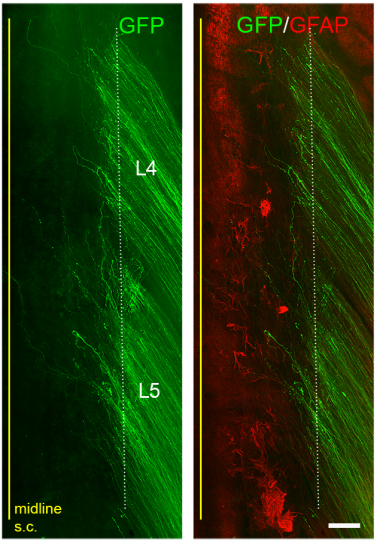
Co-targeting myelin inhibitors and CSPGs enhances sensory axon regeneration within, but not into, the spinal cord
Jinbin Zhai, Hyukmin Kim, Seung Baek Han, Meredith Manire, Rachel Yoo, Shuhuan Pang, George M. Smith, Young-Jin Son
15-PGDH Inhibition Activates the Splenic Niche to Promote Hematopoietic Regeneration
Julianne N.P. Smith, Dawn M. Dawson, Kelsey F. Christo, Alvin P. Jogasuria, Mark J. Cameron, Monika I. Antczak, Joseph M. Ready, Stanton L. Gerson, Sanford D. Markowitz, Amar B. Desai
Coordinated interactions between endothelial cells and macrophages in the islet microenvironment promote β cell regeneration
Diane C. Saunders, Kristie I. Aamodt, Tiffany M. Richardson, Alec Hopkirk, Radhika Aramandla, Greg Poffenberger, Regina Jenkins, David K. Flaherty, Nripesh Prasad, Sean E. Levy, Alvin C. Powers, Marcela Brissova
The proportion of periportal mesenchyme to ductal epithelial cells acts as a proliferative rheostat in liver regeneration
Lucía Cordero-Espinoza, Timo N. Kohler, Anna M. Dowbaj, Bernhard Strauss, Olga Sarlidou, Clare Pacini, Ross Dobie, John R. Wilson-Kanamori, Richard Butler, Palle Serup, Neil C. Henderson, Florian Hollfelder, Meritxell Huch
Loss of Kallmann syndrome-associated gene WDR11 disrupts primordial germ cell development by affecting canonical and non-canonical Hedgehog signalling
Jiyoung Lee, Yeonjoo Kim, Paris Ataliotis, Hyung-Goo Kim, Dae-Won Kim, Dorothy C. Bennett, Nigel A. Brown, Lawrence C. Layman, Soo-Hyun Kim
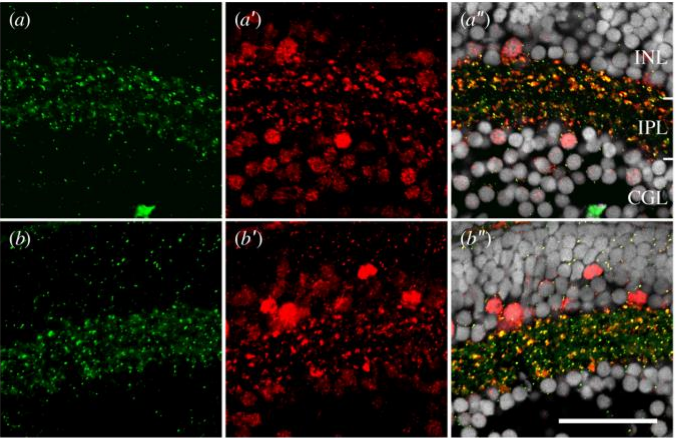
Altered visual function in a larval zebrafish knockout of neurodevelopmental risk gene pdzk1
Jiaheng Xie, Patricia R. Jusuf, Bang V. Bui, Stefanie Dudczig, Patrick T. Goodbourn
A Human Multi-Lineage Hepatic Organoid Model for Liver Fibrosis
Yuan Guan, Annika Enejder, Meiyue Wang, Zhuoqing Fang, Lu Cui, Shih-Yu Chen, Jingxiao Wang, Yalun Tan, Manhong Wu, Xinyu Chen, Patrik K. Johansson, Issra Osman, Koshi Kunimoto, Pierre Russo, Sarah C. Heilshorn, Gary Peltz
Highly enriched hiPSC-derived midbrain dopaminergic neurons robustly models Parkinson’s disease
Gurvir S Virdi, Minee L Choi, Zhi Yao, James R Evans, Dilan Athauda, Daniela Melandri, Sergiy Sylantyev, Andrey Y Abramov, Rickie Patani, Sonia Gandhi
An autism-associated calcium channel variant causes defects in neuronal polarity and axon termination in the ALM neuron of C. elegans
Tyler Buddell, Christopher C. Quinn
Targeted gene correction and functional recovery in achondroplasia patient-derived iPSCs
Huan Zou, Mingfeng Guan, Yundong Li, Fang Luo, Wenyuan Wang, Yiren Qin
| Plant development

Tuning of self-renewing capacity in the Arabidopsis stomatal lineage by hormonal and nutrition regulation of asymmetric cell divisions
Yan Gong, Julien Alassimone, Rachel Varnau, Nidhi Sharma, Lily S. Cheung, Dominique C. Bergmann
Single-Cell Resolution of Lineage Trajectories in the Arabidopsis Stomatal Lineage and Developing Leaf
Camila B. Lopez-Anido, Anne Vatén, Nicole K. Smoot, Nidhi Sharma, Victoria Guo, Yan Gong, M. Ximena Anleu Gil, Annika K. Weimer, Dominique C. Bergmann
Unique and distinct identities and functions of leaf phloem cells revealed by single cell transcriptomics
Ji-Yun Kim, Efthymia Symeonidi, Tin Yau Pang, Tom Denyer, Diana Weidauer, Margaret Bezrutczyk, Manuel Miras, Nora Zöllner, Michael M. Wudick, Martin Lercher, Li-Qing Chen, Marja C.P Timmermans, Wolf B. Frommer
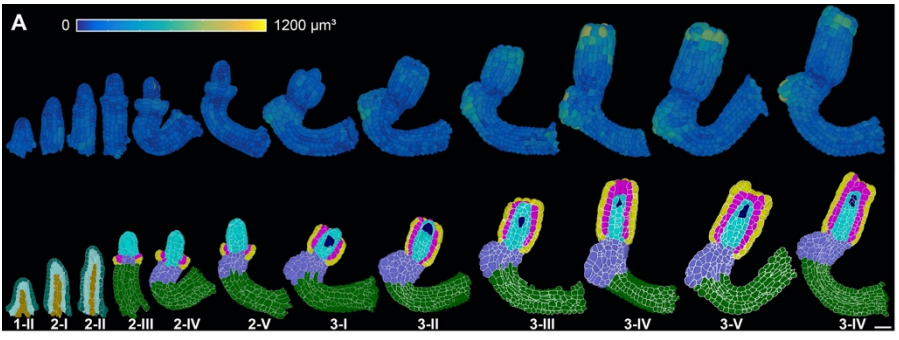
A digital 3D reference atlas reveals cellular growth patterns shaping the Arabidopsis ovule
Athul Vijayan, Rachele Tofanelli, Soeren Strauss, Lorenzo Cerrone, Adrian Wolny, Joanna Strohmeier, Anna Kreshuk, Fred A. Hamprecht, Richard S. Smith, Kay Schneitz
Polygenic adaptation of rosette growth in Arabidopsis thaliana
Benedict Wieters, Kim A. Steige, Fei He, Evan M. Koch, Sebastián E. Ramos-Onsins, Hongya Gu, Ya-Long Guo, Shamil Sunyaev, Juliette de Meaux
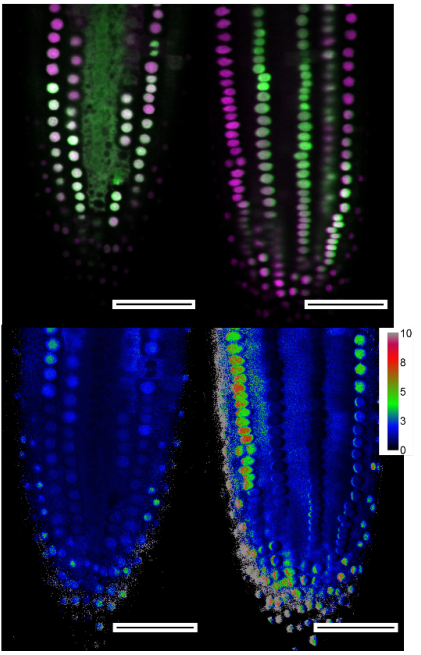
Root growth responses to mechanical impedance are regulated by a network of ROS, ethylene and auxin signalling in Arabidopsis
Amy G.R. Jacobsen, Jian Xu, Jennifer F. Topping, Keith Lindsey
Temperature-dependent fasciation mutants connect mitochondrial RNA processing to control of lateral root morphogenesis
Kurataka Otsuka, Akihito Mamiya, Mineko Konishi, Mamoru Nozaki, Atsuko Kinoshita, Hiroaki Tamaki, Masaki Arita, Masato Saito, Kayoko Yamamoto, Takushi Hachiya, Ko Noguchi, Takashi Ueda, Yusuke Yagi, Takehito Kobayashi, Takahiro Nakamura, Yasushi Sato, Takashi Hirayama, Munetaka Sugiyama
A multiscale analysis of early flower development in Arabidopsis provides an integrated view of molecular regulation and growth control
Yassin Refahi, Argyris Zardilis, Gaël Michelin, Raymond Wightman, Bruno Leggio, Jonathan Legrand, Emmanuel Faure, Laetitia Vachez, Alessia Armezzani, Anne-Evodie Risson, Feng Zhao, Pradeep Das, Nathanaël Prunet, Elliot Meyerowitz, Christophe Godin, Grégoire Malandain, Henrik Jönsson, Jan Traas
Bipartite influence of abscisic acid on xylem differentiation trajectories is dependent on distinct VND transcription factors in Arabidopsis
Prashanth Ramachandran, Frauke Augstein, Shamik Mazumdar, Thanh Van Nguyen, Elena A. Minina, Charles W. Melnyk, Annelie Carlsbecker
Endosperm development is an autonomously programmed process independent of embryogenesis
Hanxian Xiong, Wei Wang, Meng-Xiang Sun
Direct phosphorylation of HY5 by SPA1 kinase to regulate photomorphogenesis in Arabidopsis
Wenli Wang, Inyup Paik, Junghyun Kim, Xilin Hou, Sibum Sung, Enamul Huq
MicroRNA775 Promotes Intrinsic Leaf Size and Reduces Cell Wall Pectin Level via a Target Galactosyltransferase in Arabidopsis
He Zhang, Zhonglong Guo, Yan Zhuang, Yuanzhen Suo, Jianmei Du, Zhaoxu Gao, Jiawei Pan, Li Li, Tianxin Wang, Liang Xiao, Genji Qin, Yuling Jiao, Huaqing Cai, Lei Li
Integrated omics networks reveal the temporal signaling events of brassinosteroid response in Arabidopsis
Natalie M Clark, Trevor M Nolan, Ping Wang, Gaoyuan Song, Christian Montes, Hongqing Guo, Rosangela Sozzani, Yanhai Yin, Justin W Walley
A negative feedback loop of the TOR signaling moderates growth and enables rapid sensing of stress signals in plants
Muhammed Jamsheer K, Sunita Jindal, Mohan Sharma, Manvi Sharma, Sreejath Sivaj, Chanchal Thomas Mannully, Ashverya Laxmi
GUN1-independent retrograde signaling targets the ethylene pathway to repress photomorphogenesis
Charlotte M. M. Gommers, María Águila Ruiz-Sola, Alba Ayats, Lara Pereira, Marta Pujol, Elena Monte

A Spatiotemporal Molecular Switch Governs Plant Asymmetric Cell Division
Xiaoyu Guo, Chan Ho Park, Zhi-Yong Wang, Bryce E. Nickels, Juan Dong
Hybrid seed incompatibility in Capsella is connected to chromatin condensation defects in the endosperm
Katarzyna Dziasek, Lauriane Simon, Clément Lafon Placette, Benjamin Laenen, Cecilia Wärdig, Juan Santos-González, Tanja Slotte, Claudia Köhler
The wheat cytosolic glutamine synthetase GS1.1 modulates N assimilation and spike development by characterizing CRISPR-edited mutants
Yazhou Wang, Wan Teng, Yanpeng Wang, Xiang Ouyang, He Xue, Xueqiang Zhao, Caixia Gao, Yiping Tong
Shoot-derived miR2111 controls legume root and nodule development
Mengbai Zhang, Huanan Su, Peter M. Gresshoff, Brett J. Ferguson
Resetting of 24-nt siRNA landscape is initiated in the unicellular zygote in rice
Chenxin Li, Jonathan I. Gent, Hengping Xu, Hong Fu, Scott D. Russell, Venkatesan Sundaresan
Open source 3D phenotyping of chickpea plant architecture across plant development
William T. Salter, Arjina Shrestha, Margaret M Barbour
Leaf form diversification in an heirloom tomato results from alterations in two different HOMEOBOX genes
Hokuto Nakayama, Steven D. Rowland, Zizhang Cheng, Kristina Zumstein, Julie Kang, Yohei Kondo, Neelima R. Sinha
Single-nucleus RNA-seq resolves spatiotemporal developmental trajectories in the tomato shoot apex
Caihuan Tian, Qingwei Du, Mengxue Xu, Fei Du, Yuling Jiao
FRUITFULL-like genes regulate flowering time and inflorescence architecture in tomato
Xiaobing Jiang, Greice Lubini, Jose Hernandes, Kim Rijnsburger, Vera Veltkamp, Ruud A. de Maagd, Gerco C. Angenent, Marian Bemer
A cis-regulatory atlas in maize at single-cell resolution
Alexandre P. Marand, Zongliang Chen, Andrea Gallavotti, Robert J. Schmitz
Embryo CHH hypermethylation is mediated by RdDM and is autonomously directed in Brassica rapa
Tania Chakraborty, Timmy Kendall, Jeffrey W. Grover, Rebecca A. Mosher
Function of the HYDROXYCINNAMOYL-CoA:SHIKIMATE HYDROXYCINNAMOYL TRANSFERASE is evolutionarily conserved in embryophytes
Lucie Kriegshauser, Samuel Knosp, Etienne Grienenberger, Desirée D. Gütle, Iben Sørensen, Laurence Herrgott, Julie Zumsteg, Jocelyn K.C. Rose, Ralf Reski, Danièle Werck-Reichhart, Hugues Renault
Developmental variation in ovaries and kernels in a multi-kernelled rice variety- Jugal
Pallabi Saha, H.A. Murali, Bidhan Roy
Evo-devo & evo
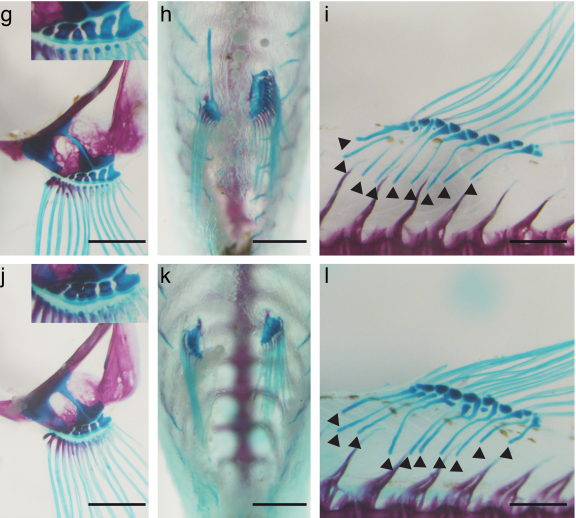
The Shh/Gli3 gene regulatory network precedes the origin of paired fins and reveals the deep homology between distal fins and digits
Joaquín Letelier, Silvia Naranjo, Ismael Sospedra, Javier Lopez-Rios, Juan Ramón Martinez-Morales, Neil Shubin, José Luis Gómez-Skarmeta
Lamprey Lecticans Link New Vertebrate Genes to the Origin and Elaboration of Vertebrate Tissues
Zachary D. Root, David Jandzik, Cara Allen, Margaux Brewer, Marek Romášek, Tyler Square, Daniel M. Medeiros
Hmx gene conservation identifies the evolutionary origin of vertebrate cranial ganglia
Vasileios Papdogiannis, Hugo J. Parker, Alessandro Pennati, Cedric Patthey, Marianne E. Bronner, Sebastian M. Shimeld
An evolutionarily acquired microRNA shapes development of mammalian cortical projections
Jessica L Diaz, Verl B Siththanandan, Victoria Lu, Nicole Gonzalez-Nava, Lincoln Pasquina, Jessica L MacDonald, Mollie B Woodworth, Abduladir Ozkan, Ramesh Nair, Zihuai He, Vibhu Sahni, Peter Sarnow, Theo D Palmer, Jeffrey D Macklis, Suzanne Tharin

Histone demethylase Lsd1 is required for the differentiation of neural cells in the cnidarian Nematostella vectensis
James M Gahan, Ivan U. Kouzel, Fabian Rentzsch
Cell shape changes during larval body plan development in Clytia hemisphaerica
Yulia Kraus, Sandra Chevalier, Evelyn Houliston
β-catenin dependent axial patterning in Cnidaria and Bilateria uses similar regulatory logic
Tatiana Bagaeva, Andrew J. Aman, Thomas Graf, Isabell Niedermoser, Bob Zimmermann, Yulia Kraus, Magdalena Schatka, Adrien Demilly, Ulrich Technau, Grigory Genikhovich
Analysis of Fox genes in Schmidtea mediterranea reveals new families and a conserved role of Smed-foxO in controlling cell death
Eudald Pascual-Carreras, Carlos Herrera-Úbeda, Maria Rosselló, Jordi Garcia-Fernandez, Emili Saló, Teresa Adell
Development of the Pre-Gnathal Segments of the Insect Head Indicates They Are Not Serial Homologues of Trunk Segments
Oren Lev, Ariel D. Chipman
The essential role of Dnmt1 in gametogenesis in the large milkweed bug Oncopeltus fasciatus
Joshua T. Washington, Katelyn R. Cavender, Ashley U. Amukamara, Elizabeth C. McKinney, Robert J. Schmitz, Patricia J. Moore

Sense organ formation and identity are controlled by divergent mechanisms in insects
Marleen Klann, Magdalena Ines Schacht, Matthew Alan Benton, Angelika Stollewerk
Secondary ossification center induces and protects growth plate structure
Meng Xie, Pavel Gol’din, Anna Nele Herdina, Jordi Estefa, Ekaterina V Medvedeva, Lei Li, Phillip T Newton, Svetlana Kotova, Boris Shavkuta, Aditya Saxena, Lauren T Shumate, Brian Metscher, Karl Großschmidt, Shigeki Nishimori, Anastasia Akovantseva, Anna P Usanova, Anastasiia D Kurenkova, Anoop Kumar, Irene Linares Arregui, Paul Tafforeau, Kaj Fried, Mattias Carlström, Andras Simon, Christian Gasser, Henry M Kronenberg, Murat Bastepe, Kimberly L. Cooper, Peter Timashev, Sophie Sanchez, Igor Adameyko, Anders Eriksson, Andrei S Chagin
X chromosome-dependent disruption of placental regulatory networks in hybrid dwarf hamsters
Thomas D. Brekke, Emily C. Moore, Shane C. Campbell-Staton, Colin M. Callahan, Zachary A. Cheviron, Jeffrey M. Good
Role of Epigenetics in Unicellular to Multicellular Transition in Dictyostelium
Simon Yuan Wang, Elizabeth Ann Pollina, I-Hao Wang, Henry L. Bushnell, Ken Takashima, Colette Fritsche, George Sabin, Paul Lieberman Greer, Eric Lieberman Greer
A rapidly evolving actin mediates fertility and developmental tradeoffs in Drosophila
Courtney M. Schroeder, Sarah A. Tomlin, John R. Valenzuela, Harmit S. Malik
Male genital lobe morphology affects the chance to copulate in Drosophila pachea
Bénédicte M. Lefèvre, Diane Catté, Virginie Courtier-Orgogozo, Michael Lang
Cis-Regulatory Differences Explaining Evolved Levels of Endometrial Invasibility in Eutherian Mammals
Yasir Suhail, Jamie D. Maziarz, Anasuya Dighe, Gunter Wagner, Kshitiz
Deciphering the evolution of the transcriptional and regulatory landscape in human placenta
Ming-an Sun, Gernot Wolf, Yejun Wang, Sherry Ralls, Anna D. Senft, Jinpu Jin, Caitlin E. Dunn-Fletcher, Louis J. Muglia, Todd S. Macfarlan
Cell biology
Asymmetric nuclear division of neural stem cells contributes to the formation of sibling nuclei with different identities
Chantal Roubinet, Ian J. White, Buzz Baum
Septins and a formin have distinct functions in anaphase chiral cortical rotation in the C. elegans zygote
Adhham Zaatri, Jenna A. Perry, Amy Shaub Maddox
Multiple pools of Protein Phosphatase 2A-B56 function to antagonize spindle assembly, promote kinetochore attachments and maintain cohesion in Drosophila Oocytes
Janet K. Jang, Amy C. Gladstein, Arunika Das, Zachary L. Sisco, Kim S. McKim
Cortical actin properties controlled by Drosophila Fos aid macrophage infiltration against surrounding tissue resistance
Vera Belyaeva, Stephanie Wachner, Igor Gridchyn, Markus Linder, Shamsi Emtenani, Attila Gyoergy, Maria Sibilia, Daria Siekhaus
Spatiotemporal expression of regulatory kinases directs the transition from mitotic growth to cellular morphogenesis
Shuo Yang, Jennifer McAdow, Yingqiu Du, Jennifer Trigg, Paul H. Taghert, Aaron N. Johnson
Modelling
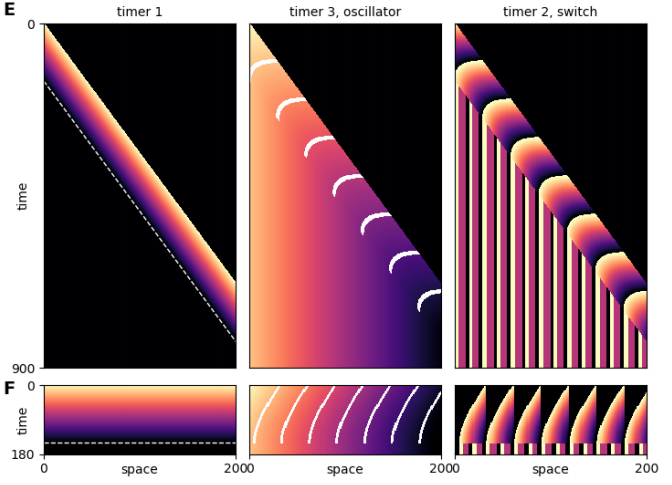
Time and Space in Segmentation
Erik Clark
A free boundary mechanobiological model of epithelial tissues
Tamara A. Tambyah, Ryan J. Murphy, Pascal R. Buenzli, Matthew J. Simpson
Heterogeneity and ‘memory’ in stem cell populations
Patrick S. Stumpf, Fumio Arai, Ben D. MacArthur
Reaction-Diffusion Model for the Arrest of Oscillations in the Somitogenesis Segmentation Clock
Jesús Pantoja-Hernández, Víctor F. Breña-medina, Moisés Santillán
Effective mechanical potential of cell–cell interaction explains basic structural units of three-dimensional morphogenesis
Hiroshi Koyama, Hisashi Okumura, Atsushi M. Ito, Tetsuhisa Otani, Kazuyuki Nakamura, Kagayaki Kato, Toshihiko Fujimori
Actin-inspired feedback couples speed and persistence in a Cellular Potts Model of cell migration
Inge M. N. Wortel, Ioana Niculescu, P. Martijn Kolijn, Nir Gov, Rob J. de Boer, Johannes Textor
The need for high-quality oocyte mitochondria at extreme ploidy dictates germline development
Marco Colnaghi, Andrew Pomiankowski, Nick Lane
Integrodifference master equation describing actively growing blood vessels in angiogenesis
L. L. Bonilla, M. Carretero, F. Terragni
Mechanical models of pattern and form in biological tissues: the role of stress-strain constitutive equations
Chiara Villa, Mark A. J. Chaplain, Tommaso Lorenzi
Directional search-and-capture model of cytoneme-based morphogenesis
Paul C Bressloff
Non-Archimedean Models of Morphogenesis
W. A. Zúñiga-Galindo
Tools & resources
SuperPlotsOfData – a web app for the transparent display and quantitative comparison of continuous data from discrete conditions
Joachim Goedhart
QuickFigures: a tool to quickly transform microscope images into quality figures
Gregory Mazo
How to use online tools to generate new hypotheses for mammary gland biology research: a case study for Wnt7b
Yorick Bernardus Cornelis van de Grift, Nika Heijmans, Renée van Amerongen
Visualizing the metazoan proliferation-terminal differentiation decision in vivo
Rebecca C. Adikes, Abraham Q. Kohrman, Michael A. Q. Martinez, Nicholas J. Palmisano, Jayson J. Smith, Taylor N. Medwig-Kinney, Mingwei Min, Maria D. Sallee, Ononnah B. Ahmed, Nuri Kim, Simeiyun Liu, Robert D. Morabito, Nicholas Weeks, Qinyun Zhao, Wan Zhang, Jessica L. Feldman, Michalis Barkoulas, Ariel M. Pani, Sabrina L. Spencer, Benjamin L. Martin, David Q. Matus

Decellularization enables functional analysis of ECM remodeling in planarian regeneration
Ekasit Sonpho, Frederick G. Mann Jr., Michaella Levy, Eric J. Ross, Carlos Guerrero-Hernández, Laurence Florens, Anita Saraf, Viraj Doddihal, Puey Ounjai, Alejandro Sánchez Alvarado
A semi-automated organoid screening method demonstrates epigenetic control of intestinal epithelial maturation
Jenny Ostrop, Rosalie Zwiggelaar, Marianne Terndrup Pedersen, François Gerbe, Korbinian Bösl, Håvard T. Lindholm, Alberto Díez-Sánchez, Naveen Parmar, Silke Radetzki, Jens Peter von Kries, Philippe Jay, Kim B. Jensen, Cheryl Arrowsmith, Menno J. Oudhoff
Single-cell analysis of chromatin silencing programs in developmental and tumor progression
Steven J. Wu, View ORCID ProfileScott N. Furlan, Anca B. Mihalas, Hatice Kaya-Okur, View ORCID ProfileAbdullah H. Feroze, Samuel N. Emerson, View ORCID ProfileYe Zheng, Kalee Carson, Patrick J. Cimino, C. Dirk Keene, View ORCID ProfileEric C. Holland, View ORCID ProfileJay F. Sarthy, View ORCID ProfileRaphael Gottardo, View ORCID ProfileKami Ahmad, View ORCID ProfileSteven Henikoff, View ORCID ProfileAnoop P. Patel
ESCargo: a regulatable fluorescent secretory cargo for diverse model organisms
Jason C. Casler, Allison L. Zajac, Fernando M. Valbuena, Daniela Sparvoli, Okunola Jeyifous, Aaron P. Turkewitz, Sally Horne-Badovinac, William N. Green, Benjamin S. Glick
Single-cell profiling of histone modifications in the mouse brain
Marek Bartosovic, Mukund Kabbe, Gonçalo Castelo-Branco
TAEL 2.0: An Improved Optogenetic Expression System for Zebrafish
Jesselynn LaBelle, Adela Ramos-Martinez, Kyle Shen, Laura B. Motta-Mena, Kevin H. Gardner, Stefan C. Materna, Stephanie Woo
A Pipeline for Precise and Efficient Genome Editing by sgRNA-Cas9 RNPs in Drosophila
Kevin G. Nyberg, Joseph Q. Nguyen, Yong-Jae Kwon, Shelby Blythe, Greg J. Beitel, Richard W. Carthew
The CONDOR pipeline for simultaneous knockdown of multiple genes identifies RBBP-5 as a germ cell reprogramming barrier in C. elegans
Marlon Kazmierczak, Carlota Farré i Díaz, Andreas Ofenbauer, Baris Tursun
CycleFlow quantifies cell-cycle heterogeneity in vivo
Adrien Jolly, Ann-Kathrin Fanti, Ines Gräßer, Nils B. Becker, Thomas Höfer
Generating single-sex litters: development of CRISPR-Cas9 genetic tools to produce all-male offspring
Charlotte Douglas, Valdone Maciulyte, Jasmin Zohren, Daniel M. Snell, Obah A. Ojarikre, Peter J.I. Ellis, James M.A. Turner
CiliaQ – a simple, open-source software for automated quantification of ciliary morphology and fluorescence in 2D, 3D, and 4D images
Jan Niklas Hansen, Sebastian Rassmann, Birthe Stüven, Nathalie Jurisch-Yaksi, Dagmar Wachten
Automated cell tracking using StarDist and TrackMate
Elnaz Fazeli, Nathan H. Roy, Gautier Follain, Romain F. Laine, Lucas von Chamier, Pekka E. Hänninen, John E. Eriksson, Jean-Yves Tinevez, Guillaume Jacquemet
Research practice & education
Preprinting the COVID-19 pandemic
Nicholas Fraser, Liam Brierley, Gautam Dey, Jessica K Polka, Máté Pálfy, Federico Nanni, Jonathon Alexis Coates
The Costs and Benefits of a Modified Biomedical Science Workforce
Michael D. Schaller
Measuring effects of trainee professional development on research productivity: A cross-institutional meta-analysis
Patrick D. Brandt, Susi Sturzenegger Varvayanis, Tracey Baas, Amanda F. Bolgioni, Janet Alder, Kimberly A. Petrie, Isabel Dominguez, Abigail M. Brown, C. Abigail Stayart, Harinder Singh, Audra Van Wart, Christine S. Chow, Ambika Mathur, Barbara M. Schreiber, David A. Fruman, Brent Bowden, Chris E. Holmquist, Daniel Arneman, Joshua D. Hall, Linda E. Hyman, Kathleen L. Gould, Roger Chalkley, Patrick J. Brennwald, Rebekah L. Layton


 (No Ratings Yet)
(No Ratings Yet)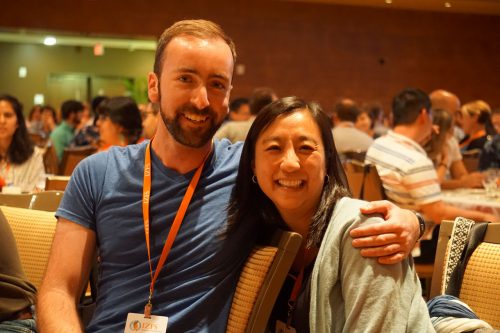
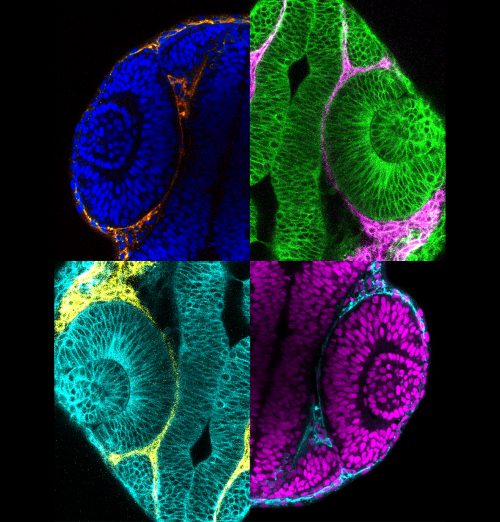
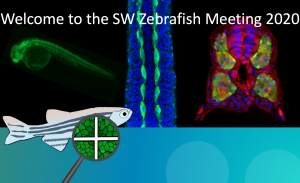
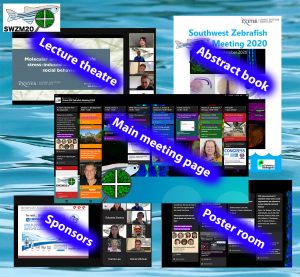
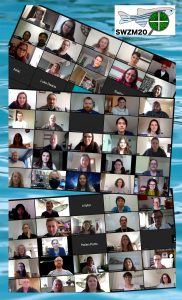
 Steffen, Lucy,
Steffen, Lucy, (5 votes)
(5 votes)

